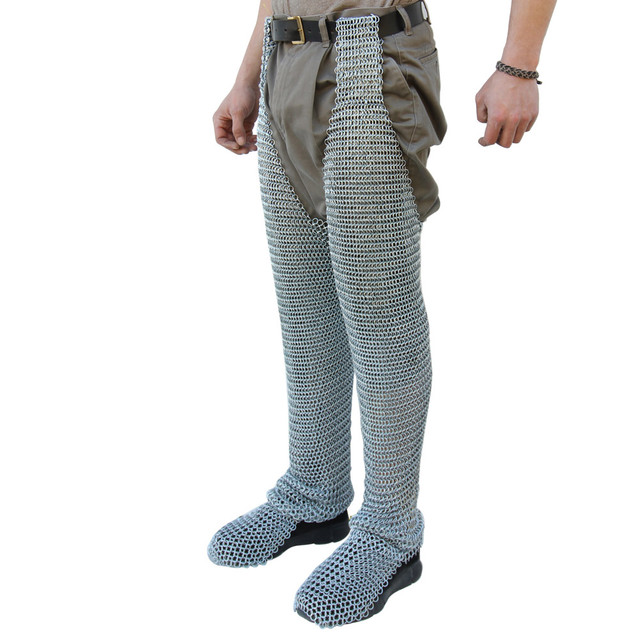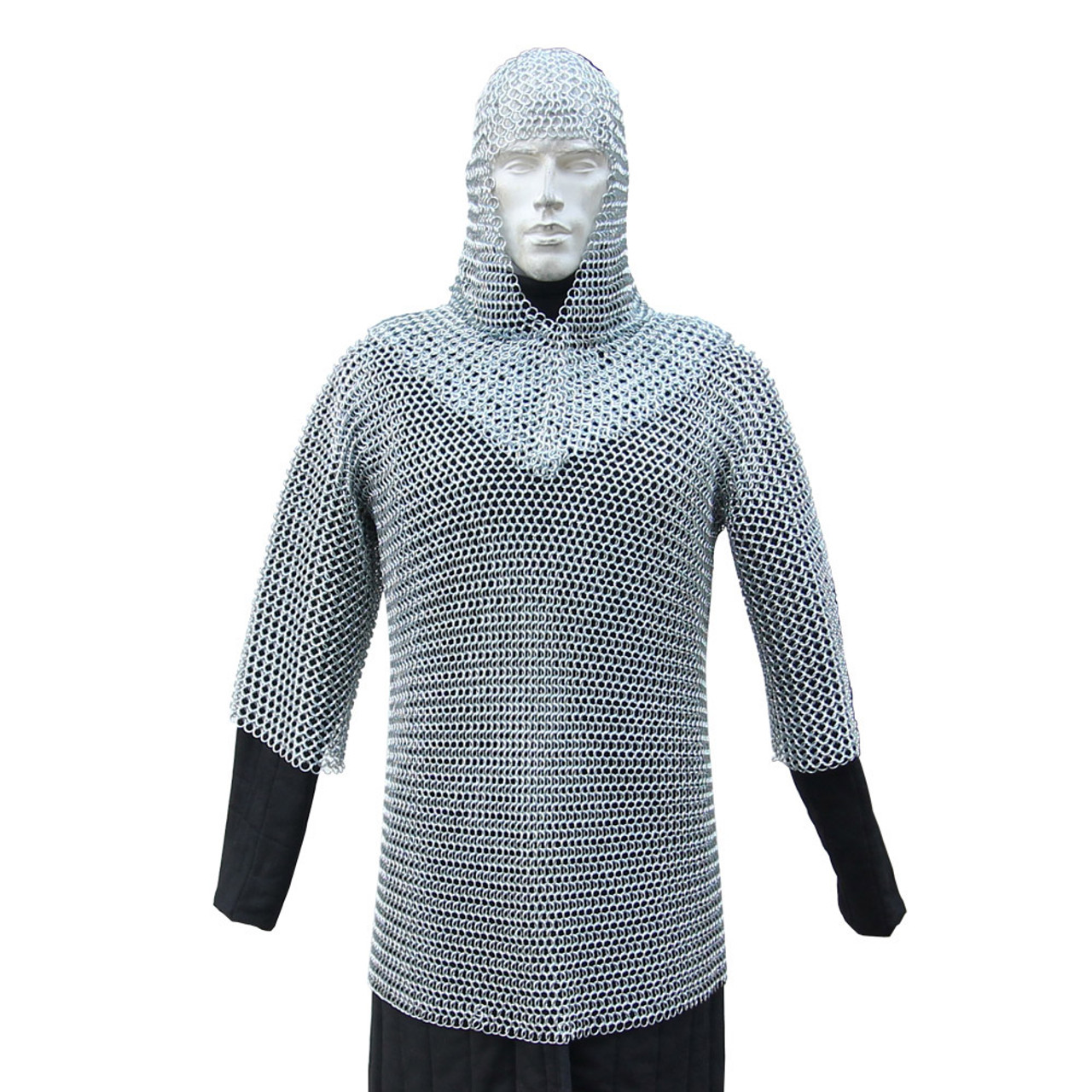Our Guide to the Best Chainmail Armor for Reenactment
Posted by SwordsSwords on Jul 3rd 2024
Reenactments transport us to bygone eras, allowing us to live the adventures of knights, warriors, and historical figures. But for a truly immersive experience, authenticity is key. And when it comes to your armor, nothing embodies historical accuracy and battlefield prowess quite like chainmail.
The perfect chainmail will safeguard you during combat scenarios, enhance your mobility, and most importantly, pay homage to the historical period you represent.This comprehensive guide, brought to you by SwordsSwords, will equip you with the knowledge to choose the perfect chainmail armor for your needs.
Types of Chainmail Armor
Chainmail, also known as mail armor, is a flexible mesh of interlocking metal rings. Worn for centuries by warriors and knights, it provides excellent protection against slashing and piercing attacks. But with various styles available, selecting the right one is crucial. Here's a breakdown of the most common types:
- Haubergeon: This knee-length coat called Haubergeon offers maximum protection. Popular with knights and heavy infantry, it extends down to the legs, providing comprehensive coverage.
- Shirt: A waist-length option, the shirt offers a good balance between protection and mobility. It's ideal for archers, skirmishers, and anyone who requires more agility.
- Coif: Protecting the head and neck, the coif is an essential piece. It comes in various styles, from simple skullcaps to designs with integrated aventails.
- Aventail: This neck and face guard is often attached to a coif. Made from mail or leather, it offers additional protection against blows and allows for better visibility.
- Chausses: These are leg coverings made from mail. Depending on the period, they can extend to the knee or ankle, offering varying degrees of protection.
Material and Construction
Now that you know the different types of chainmail, let's delve into the materials and construction methods. Understanding these aspects will help you make an informed decision.
- Ring Size and Gauge (Thickness): Chainmail armor is typically made from steel rings. The ring size and gauge (thickness) determine weight, flexibility, and durability.
- 18 Gauge Steel: This is the most common choice for reenactments. It offers a good balance between weight and protection, making it ideal for most scenarios.
- 16 Gauge Steel: This heavier gauge provides superior protection but comes at the cost of increased weight and reduced mobility. It's suitable for those portraying heavily armored characters.
- Ring Closure Methods: There are two main ways the interlocking rings are secured:
- Riveted Rings: A small rivet pierces each ring, ensuring a strong and secure connection. This method is historically accurate for earlier periods.
- Butted Rings: The rings are simply closed by pressure, creating a smoother and slightly lighter construction. This is more common in later periods.
- Material Options: While steel is the standard, you may also encounter:
- Galvanized Steel: This offers improved rust resistance but may have a slightly different appearance.
- Stainless Steel: The most corrosion-resistant option, but also the most expensive.
Choosing the Right Chainmail
Selecting the perfect armor chainmail depends on several factors:
- Weight: Chainmail can be heavy, especially heavier gauge options. Consider your physical endurance and the type of activity you'll be participating in. Swords & Swords offers a variety of weights to suit different needs.
- Mobility: Habergeons offer excellent protection but restrict movement. Shirts provide a better balance, while coifs and chausses offer targeted protection without sacrificing agility.
- Historical Accuracy: Different periods used different styles of chainmail. Research your chosen era to ensure your armor aligns with historical portrayals. Browse Swords & Swords' extensive collection to find historically accurate pieces.
- Budget: Chainmail is an investment. Set a realistic budget and explore the various options available at Swords & Swords. We offer a range of qualities and price points to suit your needs.
Essential Accessories for Chainmail
Chainmail alone doesn't provide complete protection. Here are some vital accessories:
- Gambeson: A padded undergarment, the gambeson absorbs impact and makes wearing chainmail more comfortable. It's crucial for reenactments as it helps distribute the weight of the armor and prevents chafing.
- Arming Doublet: This optional garment, worn under the gambeson, provides additional padding and comfort.
- Leather Belt: A sturdy belt is essential for several reasons. It helps distribute the weight of the chainmail more evenly across your hips and core, improving comfort and mobility. Additionally, it provides a secure point to attach weapons and other gear. Look for a high-quality leather belt specifically designed for reenactment use at Swords & Swords.
Caring for Your Chainmail Armor
Proper care ensures your chainmail lasts for years to come. Here are some key practices:
- Rust Prevention: Chainmail is susceptible to rust, especially if not cared for properly. After each use, thoroughly dry your chainmail with a clean cloth. Consider applying a thin coat of light machine oil to create a protective barrier. Swords & Swords offers a selection of maintenance products specifically designed for chainmail.
- Cleaning: For deeper cleaning, remove any dirt or grime with a soft brush and warm soapy water. Rinse thoroughly and ensure complete drying before storing. Never use harsh chemicals or abrasive cleaners, as they can damage the metal.
- Storage: Store your chainmail in a cool, dry place away from direct sunlight. Ideally, hang it on a padded hanger to prevent any unnecessary stress on the rings.
Conclusion
By considering the factors discussed above, you're well on your way to selecting the perfect chainmail armor for sale. Remember, the right chainmail will enhance your historical portrayal and overall reenactment experience.
Visit SwordsSwords, trusted by millions for all things reenactment! We offer a wide variety of high-quality chainmail armor! Find the perfect piece to complete your warrior look!
About SwordsSwords
At SwordsSwords, we are passionate about history and committed to providing reenactors with everything they need to create an immersive and authentic experience. We get our chainmail constructed from skilled artisans who use traditional techniques and high-grade materials.
Frequently Asked Questions
Is chainmail armor heavy?
Chainmail can be heavy, especially thicker gauge options. However, there are lighter weight choices available that offer a good balance between protection and mobility. Consider the type of activity you'll be participating in when making your selection.
What should I wear under chainmail?
A gambeson is an essential undergarment worn beneath chainmail. It provides padding and comfort, distributes weight, and helps prevent chafing.
How do I clean my chainmail?
For regular cleaning, use a soft brush and warm soapy water. Rinse thoroughly and ensure complete drying before storage. Avoid harsh chemicals or abrasive cleaners.
Can I customize chainmail armor?
Some vendors may offer customization options for chainmail armor. Swords & Swords offers a selection of pre-made sizes, but if you require a more tailored fit, we recommend contacting us to discuss possibilities.
Additional Resources
For further exploration of historical reenactment, consider visiting the websites of these organizations:
- The Society for Creative Anachronism (SCA):http://www.sca.org/
- Armored Combat League (ACL):https://armoredcombatsports.com/
We hope this comprehensive guide has empowered you to choose the right chainmail armor for your reenactment journey. With the proper equipment and knowledge, you can step back in time and experience the thrill of history firsthand!






